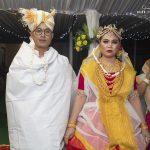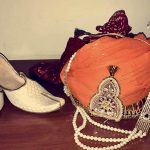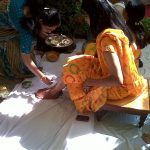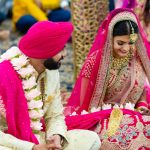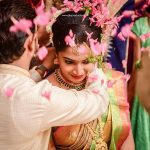Since Odisha or Orissa has a rich cultural heritage Odia marriage functions are colourful, vibrant, and fun. The colours, food, traditions, customs, and family members all come together at an Odia wedding ceremony. In this article, you will find a detailed description of Odia wedding rituals.
Odia Pre-Wedding Rituals
Orissa is an eastern coastal state of India and like the other states, it has a long history of culture, traditions, and rituals. An Odia wedding showcases these rituals and traditions. With all Indian marriages, arranged marriages and horoscope matching are common practices.
Nirbandh:
Nirbandh or Teh Vak Nischaya (translates to word of mouth) is a formal engagement ceremony. According to Odia marriage custom, only the elders are present for this event. At a temple, both parties give their words to consent to the marriage. Sankalpa is the name of this formal commitment through words. The families exchange gifts.
Jayee Anukolo:
The wedding festivities begin with this ceremony. Wedding cards are designed, printed, and distributed to mark the official wedding announcement. The family presents the first wedding card to Lord Jagannath, the supreme deity of the people of Orissa, at Jagannath Temple in Puri.
Moula Nimantrana:
The maternal uncles of the bride and groom get the second invitation.
Jwain Nimantrana:
The bride’s father and other male relatives visit the groom’s family and the bride’s side gives the third invitation to the groom’s family. The bride’s side invites the groom personally with gifts. In the end, the families sent out invitations to the rest of the guests.
Mangan:
The Odiya version of a Haldi ceremony happens a day before the wedding. Usually held in the afternoon, seven married women apply haldi on the bride’s and groom’s hands and feet. The sister-in-law of the bride or groom must be one of these married women. Next, holy water cleanses the bride and groom; this wards off the evil eye and contributes to the pre-wedding glow. The bride and groom have separate ceremonies but for destination weddings, it is one event.

Jairagodo Anukolo:
This lighting of the holy flame considers highly auspicious for the wedding. In the havan, the fire uses ghee or oil for lighting and this holy fire stays lit for all the marriage ceremonies and rituals.
Diya Mangula Puja:
This is a very traditional Odia marriage tradition. Normally the local barber’s wife offers the bride’s sari, jewellery, and a vermillion box to the Goddess for blessing. This prayer ceremony happens at the local temple and is to ensure that the bride has a long and happy married life.
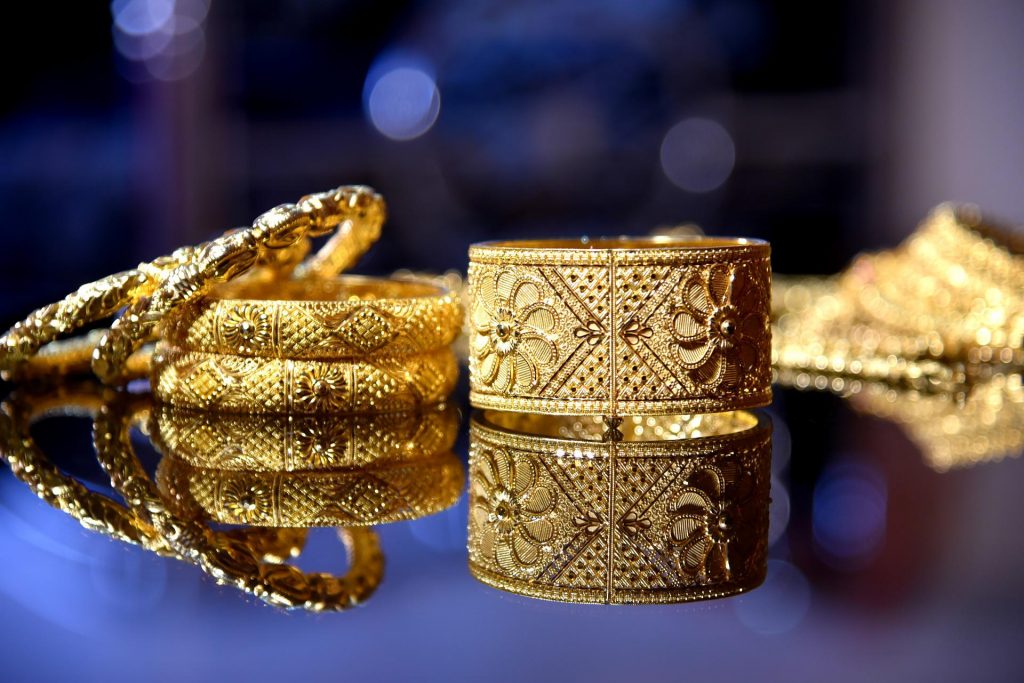
Nandimukha:
The bride’s and groom’s fathers hold the Nandimukha prayer at their respective houses and they pray to the ancestors for their blessings on the couple for a happy married life.
Odia Wedding Rituals
Barjaatri:
Accompanied by several family members, the groom leaves his house in a jovial procession. The bride’s mother or an elderly female member does a traditional aarti of the groom and she applies a tika consisting of vermillion and unbroken rice to the groom’s forehead. Coconut water washes the groom’s feet and he eats a mixture of yoghurt, ghee, and sugar or honey to eat.
Baadua Pani Gadhua:
The groom reaches the mandap. The bride goes for a holy bath to ward off evil and get ready for the Odia marriage ceremony.
Kanyadaan:
After the bride reached the mandap, the bride’s father does the Kanyadaan which is the giving away of the daughter to the groom. The bride’s father asks the groom to treat the bride with love, respect and loyalty throughout their lives.
Hatha Granthi Fita:
The bride’s father places the bride’s hand on the groom’s hand encompassed by a mango leave garland. This is the transformation of a daughter into a wife and daughter-in-law. The couple takes seven rounds of the fire while holding hands. The seven rounds are for the seven sacred wedding promises.
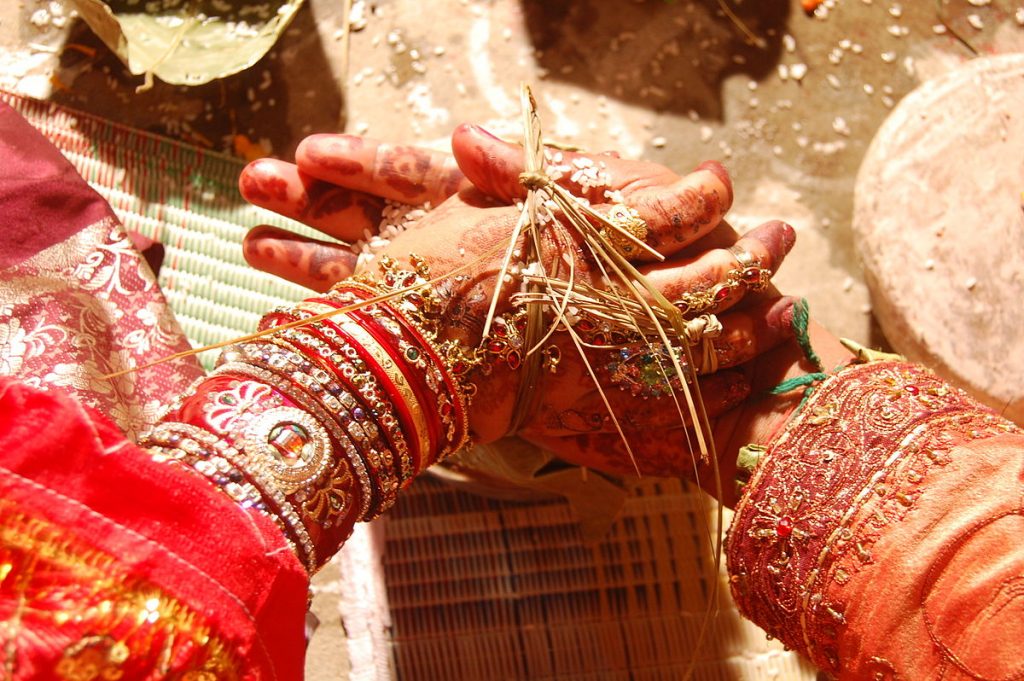
Saptapadi:
The priest blesses the seven piles of rice placed on the ground. These rice piles represent Saptakil Parwatas or the seven hills symbolising the hardships that the couple has to face during their marriage. The bride breaks these rice heaps with her right foot with the groom by her side and this indicates the seven steps for togetherness starting their married journey.
Lajahoma:
The bride’s brother places Laja or Khai, puffed rice, in the bride’s cupped hands. The groom then places his hands underneath the bride’s hand and together they offer the puffed rice to the sacred fire. The Khaipoda or Lajahom ritual appeases the Fire God to ask for blessings for the married couple.
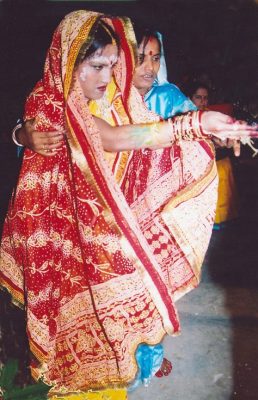
Sala Bidha:
This fun ritual involves the groom and his brother-in-law, known as the Sala. The brother-in-law playfully punches the groom on the back; this is a reminder to the groom about his new commitments and duties to his bride otherwise he is answerable to his Sala.
Sindoor Daan:
The bride and groom come outside to see the Polaris, also known as the Pole Star or North Star. Once seen, the groom applied the sindoor or vermillion powder to the bride’s hair parting and puts conch shell bangles on her hands. The Odisha style Hindu marriage is now complete.
Odia Post Wedding Rituals
Kaduri Khela:
After the marriage ceremony, the couple plays games such as with kaduri, small, white, shiny shells during this ritual named Kaduri Kehal. The groom keeps the kaduri in a closed fist and the bride tries to get them out. The switch and now it’s the groom’s turn to get them out.
Sasu Dahi-Pakhala Khia:
Next, the bride’s mother invites the groom for food. In this ritual, he has to sit on his mother-in-law’s lap and she feeds him Pakhala (cooked rice soaked in water), curd, and Baigan poda (roasted eggplants with spices).
Bahuna:
The bride’s mother sings ‘Bahuna’ songs as the bride gets ready to leave her house. Other female relatives also sing along.
Gruhaprabesha:
The mother-in-law welcomes the bride into her new home and the bride kicks the pot of rice at the threshold with her right foot. The bride is another form of the Goddess Laxmi incarnate who will bring joy, prosperity, and wealth.
Chauthi/Basara Raati:
In the marriage ceremony in Odisha Hindu culture, the groom’s family performs this prayer on the fourth day after the marriage ceremony. With the couple’s room decorated with flowers and an oil lamp, the couple eats charu (roasted coconut). The bride and groom go to their room with a glass of kesara dudha (saffron-infused milk), and the marriage is valid only after consummation.
Asta Mangala:
Eight days after the wedding, the bride and groom visit her parent’s home. The couple eats a delicious feast and spends the night.
Odia Weddings
These are the typical wedding rituals in Oriya traditions you will experience. These mouthwatering Odia dishes are just as important as the wedding rituals and traditions. These extraordinary celebrations honour the history and culture of Odisha.





